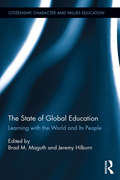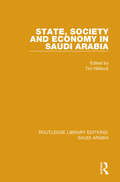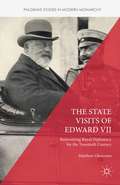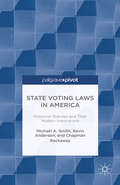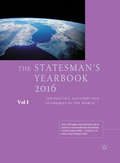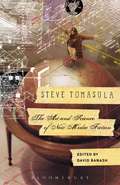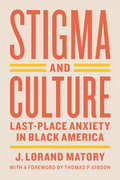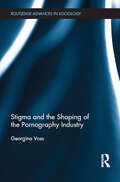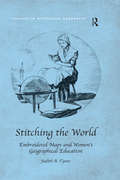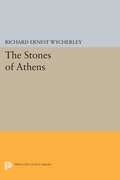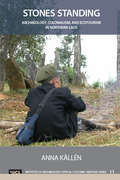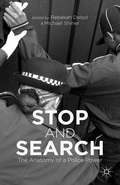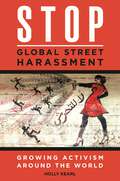- Table View
- List View
The State of Global Education: Learning with the World and its People (Citizenship, Character and Values Education)
by Brad Maguth Jeremy HilburnA battle is being waged in classrooms and capitals around the world over the goals and objectives of the future of global education. While there is growing research in the area of global education, much remains to be uncovered, challenged, and learned through sound empirical research and conceptual explorations. What type of global citizens will schools promote? What types of policies, programs and instructional practices best promote effective global citizenship? Will global education curricula advance an unwavering loyalty to neoliberal ideologies and interests over the strengthening of human rights and the environmental health of our planet? This volume presents a series of research studies and innovative instructional practices centered on advancing global learning opportunities and literacies. The authors in this volume initiate a much needed conversation on ways students in multiple contexts can and should learn with the world and its people. Part I addresses global education in theory, with a particular focus on development, intercultural competence, and global citizenship. Part II addresses educational programs and practices that foster global learning and action to help build a better future for all citizens of our planet – including experiential education, university initiatives, and conceptual approaches to teaching and learning. This scholarship spans four continents in a multitude of educational contexts – primary, secondary, and tertiary - each with a focus on a different dimension of the possibilities and pitfalls in teaching about and with the world and its people.
The State of Global Education: Learning with the World and its People (Citizenship, Character and Values Education)
by Brad M. Maguth Jeremy HilburnA battle is being waged in classrooms and capitals around the world over the goals and objectives of the future of global education. While there is growing research in the area of global education, much remains to be uncovered, challenged, and learned through sound empirical research and conceptual explorations. What type of global citizens will schools promote? What types of policies, programs and instructional practices best promote effective global citizenship? Will global education curricula advance an unwavering loyalty to neoliberal ideologies and interests over the strengthening of human rights and the environmental health of our planet? This volume presents a series of research studies and innovative instructional practices centered on advancing global learning opportunities and literacies. The authors in this volume initiate a much needed conversation on ways students in multiple contexts can and should learn with the world and its people. Part I addresses global education in theory, with a particular focus on development, intercultural competence, and global citizenship. Part II addresses educational programs and practices that foster global learning and action to help build a better future for all citizens of our planet – including experiential education, university initiatives, and conceptual approaches to teaching and learning. This scholarship spans four continents in a multitude of educational contexts – primary, secondary, and tertiary - each with a focus on a different dimension of the possibilities and pitfalls in teaching about and with the world and its people.
State, Society and Economy in Saudi Arabia (Routledge Library Editions: Saudi Arabia)
by Tim NiblockSaudi Arabia is one of the most important countries in the modern world. Not only does it possess some 25 per cent of the world’s proven oil reserves, it also plays a crucial role in the wider Gulf region where over 50 per cent of proven reserves are located. Developments in Saudi Arabia will inevitably affect the economic well-being of the Western industrialised world, Japan and much of the Third World. At the same time, Saudi Arabia is ruled in a traditional way by an all-powerful king and royal family, and is one of the key countries of Islam, the Holy City of Mecca being within the country’s boundaries. The inroad of modern Western forces into this traditional Islamic society is underlined by the fact that may key posts are filled with imported Western workers. This book, first published in 1982, containing contributions by the world’s leading Middle Eastern experts, provides a comprehensive overview of important social, political and economic developments in Saudi Arabia. The opening chapters consider the formation of the Saudi State, and the bulk of the book surveys key themes such as political opposition, the oil industry, energy policy, banking, external relations and the future direction of development.
State, Society and Economy in Saudi Arabia (Routledge Library Editions: Saudi Arabia)
by Tim NiblockSaudi Arabia is one of the most important countries in the modern world. Not only does it possess some 25 per cent of the world’s proven oil reserves, it also plays a crucial role in the wider Gulf region where over 50 per cent of proven reserves are located. Developments in Saudi Arabia will inevitably affect the economic well-being of the Western industrialised world, Japan and much of the Third World. At the same time, Saudi Arabia is ruled in a traditional way by an all-powerful king and royal family, and is one of the key countries of Islam, the Holy City of Mecca being within the country’s boundaries. The inroad of modern Western forces into this traditional Islamic society is underlined by the fact that may key posts are filled with imported Western workers. This book, first published in 1982, containing contributions by the world’s leading Middle Eastern experts, provides a comprehensive overview of important social, political and economic developments in Saudi Arabia. The opening chapters consider the formation of the Saudi State, and the bulk of the book surveys key themes such as political opposition, the oil industry, energy policy, banking, external relations and the future direction of development.
The State Visits of Edward VII: Reinventing Royal Diplomacy for the Twentieth Century (Palgrave Studies in Modern Monarchy)
by Matthew GlencrossThis book explores the revival under Edward VII of the ceremonial state visit by British monarchs, showing the impact and importance of active royal diplomacy during his reign. Using the Royal Archives, memoirs and newspapers, it reveals the contribution made by the use of ceremony and public display to popular appreciation of the monarchy.
State Voting Laws in America: Historical Statutes And Their Modern Implications
by M. Smith K. Anderson C. RackawayState Voting Laws in America documents changing views on voting rights, emphasizing court rulings which shaped our understanding of what constitutes a legitimate right to vote.
The Statesman's Yearbook 2016: The Politics, Cultures And Economies Of The World (The\statesman's Yearbook Ser.)
by Nick Heath-BrownStatistik für alle: Die 101 wichtigsten Begriffe anschaulich erklärt
by Walter KrämerDie Statistik und ihre Anwendung in unserem Leben in 101 Stichwörtern kurz, prägnant und verständlich erklären kann nur Walter Krämer. Ob es um die Zusammensetzung der Arbeitslosenquote geht, Aktienkurse, Wahlprognosen, Intelligenzquotient, polizeiliche Kriminalstatistik oder um Klinische Studien und Big Data: Der Leser erhält genau die Informationen, die er benötigt, um im täglichen Leben mit Statistik sinnvoll umgehen zu können. Dazu muss man kein Rechen-As sein oder Mathematik studiert haben. Ein gesunder Menschenverstand und die Bereitschaft, den Tatsachen ohne Vorurteile ins Gesicht zu sehen reichen vollkommen aus, um die Kunst der Statistik schätzen zu lernen: den Schein vom Sein zu trennen und die Stecknadel im Heuhaufen zu finden. Dieses Buch ist ein gleichermaßen verständlicher, faszinierender, amüsanter wie auch und hilfreicher als Ratgeber für unseren täglichen Umgang mit Statistik: denn nur wer versteht kann mitreden und entlarven.
Steve Tomasula: The Art and Science of New Media Fiction
by David BanashSteve Tomasula's work exists at the cutting edges of scientific knowledge and literary techniques. As such, it demands consideration from multiple perspectives and from critics who can guide the reader through the formal innovations and multimedia involutions while providing critical scientific, aesthetic, historical, and technical contexts. This book, the first of its kind, provides this framework, showing readers the richness and relevance of the worlds Tomasula constructs.Steve Tomasula's work is redefining the form of the novel, reinventing the practice of reading, and wrestling with the most urgent questions raised by massive transformations of media and biotechnologies. His work not only charts these changes, it formulates the problems that we have making meaning in our radically changing technological contexts. Vast in scope, inventive in form, and intimate in voice, his novels, short stories, and essays are read and taught by a surprisingly diverse array of scholars in fields ranging from contemporary experimental writing and literary criticism to the history of science, biotechnology and bioart, book studies, and digital humanities.
Steve Tomasula: The Art and Science of New Media Fiction
by David BanashSteve Tomasula's work exists at the cutting edges of scientific knowledge and literary techniques. As such, it demands consideration from multiple perspectives and from critics who can guide the reader through the formal innovations and multimedia involutions while providing critical scientific, aesthetic, historical, and technical contexts. This book, the first of its kind, provides this framework, showing readers the richness and relevance of the worlds Tomasula constructs.Steve Tomasula's work is redefining the form of the novel, reinventing the practice of reading, and wrestling with the most urgent questions raised by massive transformations of media and biotechnologies. His work not only charts these changes, it formulates the problems that we have making meaning in our radically changing technological contexts. Vast in scope, inventive in form, and intimate in voice, his novels, short stories, and essays are read and taught by a surprisingly diverse array of scholars in fields ranging from contemporary experimental writing and literary criticism to the history of science, biotechnology and bioart, book studies, and digital humanities.
Stigma and Culture: Last-Place Anxiety in Black America (Lewis Henry Morgan Lecture Series)
by J. Lorand MatoryIn Stigma and Culture, J. Lorand Matory provocatively shows how ethnic identification in the United States—and around the globe—is a competitive and hierarchical process in which populations, especially of historically stigmatized races, seek status and income by dishonoring other stigmatized populations. And there is no better place to see this than among the African American elite in academia, where he explores the emergent ethnic identities of African and Caribbean immigrants and transmigrants, Gullah/Geechees, Louisiana Creoles, and even Native Americans of partly African ancestry. Matory describes the competitive process that hierarchically structures their self-definition as ethnic groups and the similar process by which middle-class African Americans seek distinction from their impoverished compatriots. Drawing on research at universities such as Howard, Harvard, and Duke and among their alumni networks, he details how university life—while facilitating individual upward mobility, touting human equality, and regaling cultural diversity—also perpetuates the cultural standards that historically justified the dominance of some groups over others. Combining his ethnographic findings with classic theoretical insights from Frantz Fanon, Fredrik Barth, Erving Goffman, Pierre Bourdieu and others—alongside stories from his own life in academia—Matory sketches the university as an institution that, particularly through the anthropological vocabulary of culture, encourages the stigmatized to stratify their own.
Stigma and Culture: Last-Place Anxiety in Black America (Lewis Henry Morgan Lecture Series)
by J. Lorand MatoryIn Stigma and Culture, J. Lorand Matory provocatively shows how ethnic identification in the United States—and around the globe—is a competitive and hierarchical process in which populations, especially of historically stigmatized races, seek status and income by dishonoring other stigmatized populations. And there is no better place to see this than among the African American elite in academia, where he explores the emergent ethnic identities of African and Caribbean immigrants and transmigrants, Gullah/Geechees, Louisiana Creoles, and even Native Americans of partly African ancestry. Matory describes the competitive process that hierarchically structures their self-definition as ethnic groups and the similar process by which middle-class African Americans seek distinction from their impoverished compatriots. Drawing on research at universities such as Howard, Harvard, and Duke and among their alumni networks, he details how university life—while facilitating individual upward mobility, touting human equality, and regaling cultural diversity—also perpetuates the cultural standards that historically justified the dominance of some groups over others. Combining his ethnographic findings with classic theoretical insights from Frantz Fanon, Fredrik Barth, Erving Goffman, Pierre Bourdieu and others—alongside stories from his own life in academia—Matory sketches the university as an institution that, particularly through the anthropological vocabulary of culture, encourages the stigmatized to stratify their own.
Stigma and Culture: Last-Place Anxiety in Black America (Lewis Henry Morgan Lecture Series)
by J. Lorand MatoryIn Stigma and Culture, J. Lorand Matory provocatively shows how ethnic identification in the United States—and around the globe—is a competitive and hierarchical process in which populations, especially of historically stigmatized races, seek status and income by dishonoring other stigmatized populations. And there is no better place to see this than among the African American elite in academia, where he explores the emergent ethnic identities of African and Caribbean immigrants and transmigrants, Gullah/Geechees, Louisiana Creoles, and even Native Americans of partly African ancestry. Matory describes the competitive process that hierarchically structures their self-definition as ethnic groups and the similar process by which middle-class African Americans seek distinction from their impoverished compatriots. Drawing on research at universities such as Howard, Harvard, and Duke and among their alumni networks, he details how university life—while facilitating individual upward mobility, touting human equality, and regaling cultural diversity—also perpetuates the cultural standards that historically justified the dominance of some groups over others. Combining his ethnographic findings with classic theoretical insights from Frantz Fanon, Fredrik Barth, Erving Goffman, Pierre Bourdieu and others—alongside stories from his own life in academia—Matory sketches the university as an institution that, particularly through the anthropological vocabulary of culture, encourages the stigmatized to stratify their own.
Stigma and Culture: Last-Place Anxiety in Black America (Lewis Henry Morgan Lecture Series)
by J. Lorand MatoryIn Stigma and Culture, J. Lorand Matory provocatively shows how ethnic identification in the United States—and around the globe—is a competitive and hierarchical process in which populations, especially of historically stigmatized races, seek status and income by dishonoring other stigmatized populations. And there is no better place to see this than among the African American elite in academia, where he explores the emergent ethnic identities of African and Caribbean immigrants and transmigrants, Gullah/Geechees, Louisiana Creoles, and even Native Americans of partly African ancestry. Matory describes the competitive process that hierarchically structures their self-definition as ethnic groups and the similar process by which middle-class African Americans seek distinction from their impoverished compatriots. Drawing on research at universities such as Howard, Harvard, and Duke and among their alumni networks, he details how university life—while facilitating individual upward mobility, touting human equality, and regaling cultural diversity—also perpetuates the cultural standards that historically justified the dominance of some groups over others. Combining his ethnographic findings with classic theoretical insights from Frantz Fanon, Fredrik Barth, Erving Goffman, Pierre Bourdieu and others—alongside stories from his own life in academia—Matory sketches the university as an institution that, particularly through the anthropological vocabulary of culture, encourages the stigmatized to stratify their own.
Stigma and Culture: Last-Place Anxiety in Black America (Lewis Henry Morgan Lecture Series)
by J. Lorand MatoryIn Stigma and Culture, J. Lorand Matory provocatively shows how ethnic identification in the United States—and around the globe—is a competitive and hierarchical process in which populations, especially of historically stigmatized races, seek status and income by dishonoring other stigmatized populations. And there is no better place to see this than among the African American elite in academia, where he explores the emergent ethnic identities of African and Caribbean immigrants and transmigrants, Gullah/Geechees, Louisiana Creoles, and even Native Americans of partly African ancestry. Matory describes the competitive process that hierarchically structures their self-definition as ethnic groups and the similar process by which middle-class African Americans seek distinction from their impoverished compatriots. Drawing on research at universities such as Howard, Harvard, and Duke and among their alumni networks, he details how university life—while facilitating individual upward mobility, touting human equality, and regaling cultural diversity—also perpetuates the cultural standards that historically justified the dominance of some groups over others. Combining his ethnographic findings with classic theoretical insights from Frantz Fanon, Fredrik Barth, Erving Goffman, Pierre Bourdieu and others—alongside stories from his own life in academia—Matory sketches the university as an institution that, particularly through the anthropological vocabulary of culture, encourages the stigmatized to stratify their own.
Stigma and Culture: Last-Place Anxiety in Black America (Lewis Henry Morgan Lecture Series)
by J. Lorand MatoryIn Stigma and Culture, J. Lorand Matory provocatively shows how ethnic identification in the United States—and around the globe—is a competitive and hierarchical process in which populations, especially of historically stigmatized races, seek status and income by dishonoring other stigmatized populations. And there is no better place to see this than among the African American elite in academia, where he explores the emergent ethnic identities of African and Caribbean immigrants and transmigrants, Gullah/Geechees, Louisiana Creoles, and even Native Americans of partly African ancestry. Matory describes the competitive process that hierarchically structures their self-definition as ethnic groups and the similar process by which middle-class African Americans seek distinction from their impoverished compatriots. Drawing on research at universities such as Howard, Harvard, and Duke and among their alumni networks, he details how university life—while facilitating individual upward mobility, touting human equality, and regaling cultural diversity—also perpetuates the cultural standards that historically justified the dominance of some groups over others. Combining his ethnographic findings with classic theoretical insights from Frantz Fanon, Fredrik Barth, Erving Goffman, Pierre Bourdieu and others—alongside stories from his own life in academia—Matory sketches the university as an institution that, particularly through the anthropological vocabulary of culture, encourages the stigmatized to stratify their own.
Stigma and the Shaping of the Pornography Industry (Routledge Advances in Sociology)
by Georgina VossThe idea of ‘pornography’ is often employed to invoke titillation, anger, and disgust. Stigma and the Shaping of the Pornography Industry explores the effects that this stigmatized identity has on the pornography industry itself. From the video era to the emergence of the internet, to trade shows, white-collar workers, technological innovation, and industry-wide characteristics, this book looks beyond content production to explore how stigma has shaped the structures, practices, norms, and boundaries of the wider sector. By drawing on concepts such as dirty work, core-stigmatized industries, and outlaw innovation, this book offers rich insights into the ways in which stigma is socially constructed and managed, and the deep structural effects that it has on the industry.
Stigma and the Shaping of the Pornography Industry (Routledge Advances in Sociology)
by Georgina VossThe idea of ‘pornography’ is often employed to invoke titillation, anger, and disgust. Stigma and the Shaping of the Pornography Industry explores the effects that this stigmatized identity has on the pornography industry itself. From the video era to the emergence of the internet, to trade shows, white-collar workers, technological innovation, and industry-wide characteristics, this book looks beyond content production to explore how stigma has shaped the structures, practices, norms, and boundaries of the wider sector. By drawing on concepts such as dirty work, core-stigmatized industries, and outlaw innovation, this book offers rich insights into the ways in which stigma is socially constructed and managed, and the deep structural effects that it has on the industry.
Stitching the World: Embroidered Maps And Women's Geographical Education (Studies in Historical Geography)
by Judith A. TynerFrom the late eighteenth century until about 1840, schoolgirls in the British Isles and the United States created embroidered map samplers and even silk globes. Hundreds of British maps were made and although American examples are more rare, they form a significant collection of artefacts. Descriptions of these samplers stated that they were designed to teach needlework and geography. The focus of this book is not on stitches and techniques used in 'drafting' the maps, but rather why they were developed, how they diffused from the British Isles to the United States, and why they were made for such a brief time. The events of the late eighteenth and early nineteenth centuries stimulated an explosion of interest in geography. The American and French Revolutions, the wars between France and England, the War of 1812, Captain Cook's voyages, and the explorations of Lewis and Clark made the study of places exciting and important. Geography was the first science taught to girls in school. This period also coincided with major changes in educational theories and practices, especially for girls, and this book uses needlework maps and globes to chart a broader discussion of women's geographic education. In this light, map samplers and embroidered globes represent a transition in women's education from 'accomplishments' in the eighteenth century to challenging geographic education and conventional map drawing in schools and academies of the second half of the nineteenth century. There has been little serious study of these maps by cartographers and, moreover, historians of cartography have largely neglected the role of women in mapping. Children's maps have not been studied, although they might have much to offer about geographical teaching and perceptions of a period, and map samplers have been dismissed because they are the work of schoolgirls. Needlework historians, likewise, have not done in depth studies of map samplers until recently. Stitching the World is an interdisciplinary work drawing on cartography, needlework, and material culture. This book for the first time provides a critical analysis of these artefacts, showing that they offer significant insights into both eighteenth- and nineteenth-century geographic thought and cartography in the USA and the UK and into the development of female education.
Stitching the World: Embroidered Maps and Women’s Geographical Education (Studies in Historical Geography)
by Judith A. TynerFrom the late eighteenth century until about 1840, schoolgirls in the British Isles and the United States created embroidered map samplers and even silk globes. Hundreds of British maps were made and although American examples are more rare, they form a significant collection of artefacts. Descriptions of these samplers stated that they were designed to teach needlework and geography. The focus of this book is not on stitches and techniques used in 'drafting' the maps, but rather why they were developed, how they diffused from the British Isles to the United States, and why they were made for such a brief time. The events of the late eighteenth and early nineteenth centuries stimulated an explosion of interest in geography. The American and French Revolutions, the wars between France and England, the War of 1812, Captain Cook's voyages, and the explorations of Lewis and Clark made the study of places exciting and important. Geography was the first science taught to girls in school. This period also coincided with major changes in educational theories and practices, especially for girls, and this book uses needlework maps and globes to chart a broader discussion of women's geographic education. In this light, map samplers and embroidered globes represent a transition in women's education from 'accomplishments' in the eighteenth century to challenging geographic education and conventional map drawing in schools and academies of the second half of the nineteenth century. There has been little serious study of these maps by cartographers and, moreover, historians of cartography have largely neglected the role of women in mapping. Children's maps have not been studied, although they might have much to offer about geographical teaching and perceptions of a period, and map samplers have been dismissed because they are the work of schoolgirls. Needlework historians, likewise, have not done in depth studies of map samplers until recently. Stitching the World is an interdisciplinary work drawing on cartography, needlework, and material culture. This book for the first time provides a critical analysis of these artefacts, showing that they offer significant insights into both eighteenth- and nineteenth-century geographic thought and cartography in the USA and the UK and into the development of female education.
The Stones of Athens
by Richard Ernest WycherleyInterpreting the monuments of Athens in light of literature, R. E. Wycherley brings before us the city the ancients knew. Philosophers, statesmen, travelers, dramatists, poets, private citizens—the words of all these suggest how the city looked at various periods, how its monuments came to be built, and how they served the people in daily life. Professor Wycherley concentrates on the classical period, illustrating his work with plans, reconstructions, and photographs.Originally published in 1978.The Princeton Legacy Library uses the latest print-on-demand technology to again make available previously out-of-print books from the distinguished backlist of Princeton University Press. These editions preserve the original texts of these important books while presenting them in durable paperback and hardcover editions. The goal of the Princeton Legacy Library is to vastly increase access to the rich scholarly heritage found in the thousands of books published by Princeton University Press since its founding in 1905.
Stones Standing: Archaeology, Colonialism, and Ecotourism in Northern Laos (UCL Institute of Archaeology Critical Cultural Heritage Series)
by Anna KällénThis book is an inquiry into the relationships between archaeology, colonialism and ecotourism at the famous standing stones of Hintang, Laos. It investigates the conditions under which archaeological knowledge has been produced, appropriated, contested, commodified, and consumed by colonialism from the 1930s until today and what it shows about the power dynamics of heritage and ecotourism. The volume-explores how the discourses of colonialism and ecotourism affect tourists, archaeologists, heritage managers, and the local community;-is written as a set of overlapping creative essays, each giving an overlapping perspective on Hintang;-is a multidisciplinary research project based on ethnographic fieldwork, archival research, interviews with community members, biography, material culture studies, and text analysis.
Stones Standing: Archaeology, Colonialism, and Ecotourism in Northern Laos (UCL Institute of Archaeology Critical Cultural Heritage Series)
by Anna KällénThis book is an inquiry into the relationships between archaeology, colonialism and ecotourism at the famous standing stones of Hintang, Laos. It investigates the conditions under which archaeological knowledge has been produced, appropriated, contested, commodified, and consumed by colonialism from the 1930s until today and what it shows about the power dynamics of heritage and ecotourism. The volume-explores how the discourses of colonialism and ecotourism affect tourists, archaeologists, heritage managers, and the local community;-is written as a set of overlapping creative essays, each giving an overlapping perspective on Hintang;-is a multidisciplinary research project based on ethnographic fieldwork, archival research, interviews with community members, biography, material culture studies, and text analysis.
Stop and Search: The Anatomy of a Police Power (Routledge Frontiers Of Criminal Justice Ser.)
by Rebekah DelsolThis book reviews the key controversies surrounding the police power to stop and search members of the public. It explores the history and development of these powers, assesses their effectiveness in tackling crime and their impact on public trust and confidence as well as on-going attempts at regulation and reform.
Stop Global Street Harassment: Growing Activism around the World
by Holly KearlOnce a largely dismissed problem, street harassment is now headline news and being addressed by many international agencies and governments worldwide. This book details how a growing number of individuals, small groups, international organizations, and government agencies worldwide are working to create safe public spaces.Everyone should be able to navigate through public spaces without facing harassment or the threat of sexual assault, yet that is a right that millions of people worldwide are routinely denied. In the United States alone, 65 percent of women and 25 percent of men experience street harassment. This book taps personal stories, research data, news stories, and information about global campaigns and grassroots action in dozens of countries to trace the growing social movement to recognize, address, and prevent street harassment. The author suggests what steps need to be taken next to help stop street harassment globally and invites readers to take action and be part of the solution.The book addresses specific and prominent incidents of street harassment such as the mass sexual assaults of women at Tahrir Square in Cairo, Egypt; the gang rape and murder of a young woman on a bus in Delhi, India, in 2012; and the viral hidden-camera video produced by Hollaback!, an advocacy group dedicated to ending street harassment, that documents the catcalling and stalking that happens to a woman as she walks through New York City. It documents the explosion of studies, personal story sharing, grassroots campaigns, and media attention on street harassment since 2010 as well as Global Safe Cities efforts by international organizations like UN Women and ActionAid in countries on all six continents during that time period. Attention is also paid to the ongoing lack of enforcement of laws on street harassment by police and judges. The book concludes by looking forward at remedies for the problem: education among youth about street harassment and addressing issues of consent and respect.
